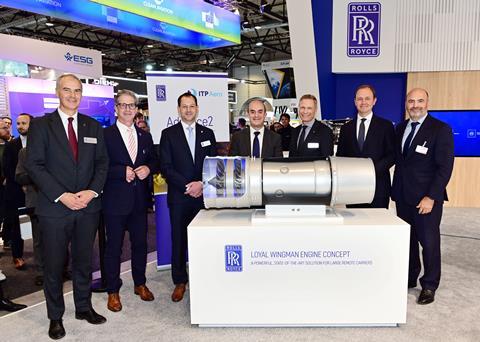Rolls-Royce’s German unit and Spain-based ITP Aero have joined forces to pursue a new engine based on the former’s Advance2 two-spool core designed to equip a future ‘loyal wingman’ uncrewed aircraft in the 10t-plus class to enter service in the early part of next decade.
Disclosed at the ILA Berlin air show on 5 June, where the pair unveiled an engine mock-up, the developmental powerplant would leverage technologies deployed on Rolls-Royce’s Pearl-series business jet engines – turbofans with thrust in the 15,000-18,000lb (67-80kN) range.

Covered by a memorandum of understanding – signed in the presence of representatives from the defence ministries of Germany and Spain – the pact will see the pair explore a partnership to “design, develop, manufacture and support” an engine for loyal wingman aircraft.
Designed to operate alongside a manned sixth-generation fighter, an Airbus Defence & Space-designed “remote carrier” aircraft forms a central pillar of the tri-national Future Combat Air System (FCAS) programme being developed for France, Germany and Spain.
Airbus also unveiled a ‘Wingman’ concept at the show – likening the design to a concept car, but has yet to select a propulsion system supplier such a platform. ITP is already collaborating with Safran Aircraft Engines and MTU Aero through the EUMET venture to develop an engine for the manned fighter element of FCAS.
Dr Dirk Geisinger, head of Rolls-Royce Deutschland, says the loyal wingman engine concept is based on “robust and reliable” technologies the propulsion specialist has been developing in Germany over the past decades.
But he stresses that such a concept “only works with strong partners” and believes working with ITP – owned by Rolls-Royce until its sale in 2022 – will help to “foster this German-Spanish relationship”.
Carlos Alzola, managing director of ITP Aero, says the MoU “signifies a commitment to excellence and innovation in European aerospace” and will “contribute to the development of a European propulsion solution” showcasing both nations’ capabilities.
Rene Bernstein, vice-president defence business development and future programmes at Rolls-Royce Deutschland, says the armed forces of the two countries will be able to benefit from the investments “in modern technology made over the last five years”.
This approach “reduces the overall investment required” to bring a new engine to market, he says, ensuring it is “competitive” and “affordable”.
“We have got the technology – it’s ready, we just need to modify the outer design of the core.
“This brings us to the fact that we can reuse 90% of existing technology and generate a massive saving.” A new engine could be available and certified “within six years”, he says.
Alvaro Santodomingo Martell, executive director of ITP’s defence business unit, says the pact “builds on more than 20 years of collaboration” and allows the pair to “push forward a truly European solution for a potential ‘Loyal Wingman’ [of] over 10 tonnes”.
Bernstein declines to specify the exact thrust-class of the engine but says it will be at the “upper end” of the Pearl family. The most powerful of those engines, the Pearl 10X, will produce more than 18,200lb of thrust when it enters service on the Dassault Falcon 10X.
An afterburning capability remains an option, adds Bernstein, and could also address demand for supersonic speeds if required. “We have looked into this already,” he says.
Although the companies have their domestic customers in mind, they see a “global demand” for a future powerplant, says Bernstein.
The workshare split between the two companies on the development has yet to be fully determined, says Bernstein: “Those conversations will begin now,” he says.
However, a customer will be required for the programme to advance to the next stage – a step which will also define each company’s area of work based on the exact technical requirements of the engine.
Martell says the mock-up of the engine the pair revealed at ILA is based around “common customer requirements”, but stresses that the design will evolve in line with more precise specifications.
“Obviously as opportunities come along, programmes get launched and the requirements change, we will adapt the engine concept to make it the most suitable competitive solution.”
Rolls-Royce’s UK defence arm has also built and run a small, clean-sheet two-spool engine demonstrator called Orpheus designed for uncrewed applications.
However, Bernstein points out that while that powerplant was developed “from scratch”, the Rolls-Royce Deutschland-ITP team “took a different approach” and “looked what we had available… and can just build around it and provide a product right away”.































